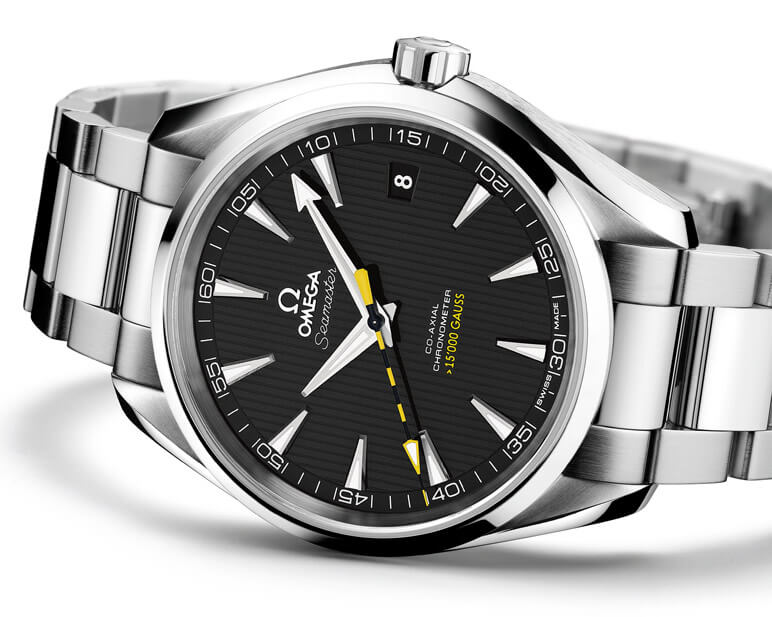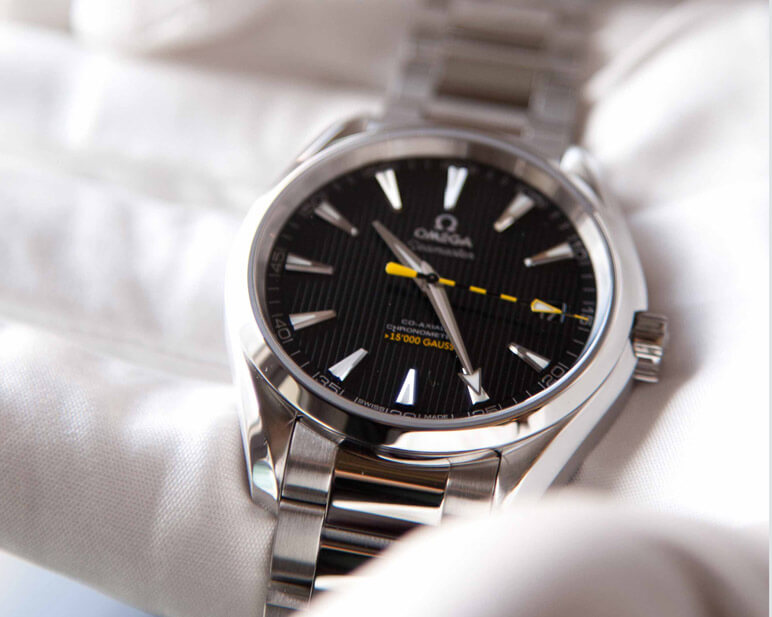Although full details won’t be revealed until Baselworld at end April, Omega couldn’t wait to lift a corner of the veil, and convened an international press conference in Geneva to present the result of its latest research: the Seamaster Aqua Terra 15’000 Gauss. The engineers at Asulab (Swatch Group’s R&D platform), ETA and Omega have tackled the very real problem, for watches, of magnetic fields and come out the other side with the solution many had deemed “impossible to find,” in the words of Jean-Claude Monachon, Vice President Product Development at Omega: rather than protecting the movement inside a container, they have made it insensitive to magnetic fields. Only Cartier, in 2009, had addressed the problem from the same angle with its ID One. But whereas Cartier never intended to bring its prototype to market, the Seamaster Aqua Terra 15’000 Gauss will go on sale from October 2013 as an unlimited series. Better still, come 2015-2016, Omega intends fitting this new movement into all its Co-Axial watches.
A hostile environment
Not only are there magnetic fields everywhere we turn, the number and strength of magnets around us continues to grow. There are magnets on bag clasps, children’s toys and fridge doors. Even the paper-clip holder on our desk is a magnet. And that’s not all. Electromagnetic fields are present in countless areas of daily life. Transport (train locomotives), leisure (ski-lift turnstiles), industry (induction furnaces) and telecom (cellphone tower antennas) are all concerned. The most powerful magnetic forces to which we can be exposed are in the medical sector and magnetic resonance imaging (MRI) which produces a magnetic field in the region of 15,000 gauss.
These disruptive elements, and many others, can compromise the performance of a mechanical watch. At just 80 gauss, it can suffer anything from a temporary loss of accuracy to stopping the movement dead. To give some idea of scale, certain magnets in common use today, which are made from neodymium, iron and boron, have a strength of 1.4 tesla. That’s 14,000 gauss! The most common effect of magnetic fields is runaway. “A magnetic field can produce a residual effect,” explained Michel Willemin who is CEO of Asulab. “When you expose a screwdriver to a magnet, it becomes magnetised itself and starts attracting screws. If the same thing happens to a mechanical movement, the oscillator is permanently disrupted.” Nor is this a purely theoretical phenomenon. Around 15% of returns to Omega are caused by magnetisation. In 2009, Cartier revealed that 80% of returns in its Asian market, where magnetic gadgets are in widespread use, were the result of magnetisation.
An innovative solution
Magnetic fields are a longstanding bugbear for the watch industry. Back in 1954, Rolex launched the first watch, the Oyster Perpetual Milgauss, that could withstand magnetic fields up to 1,000 gauss. IWC followed suit a year later with an Ingénieur watch whose 2005 version could also handle up to 1,000 gauss. In 1957, Omega stepped up with the Aqua Terra Railmaster that takes 900 gauss on the chin. The technique at that time was to enclose the movement inside a protective case that repelled magnetic fields. Thierry Conus, head of R&D at ETA, listed the three drawbacks of this solution: “Firstly, these containers are ineffective above 1,000 gauss; secondly, they interact with magnetic fields and could ultimately be attracted to a magnet, in an MRI machine for example; thirdly, they have to be completely sealed which rules out the opportunity for a transparent case back or a date window.”
Omega started from a blank sheet, looking for a solution that would make the mechanical movement insensitive to magnetic fields and be suitable for mass production. “Omega is a high-end brand whose watches are equipped with industrial movements,” Raynald Aeschlimann, Vice President and International Sales Director, reminded the press conference. “We had to develop a calibre at less than CHF 6,000.” This meant choosing materials carefully, but also focusing on component design. In both cases, the end result had to fit with standard industrial processes. The new movement benefits from the silicon balance spring which Omega introduced in 2008, and the Co-Axial escapement in nickel-phosphorous, both of which are anti-magnetic. As for the rest… no comment! The only other snippet of information is that the balance staff is titanium. “We’ve called a press conference today because the patent applications have been filed,” said Aeschlimann, “but the watch is still at the prototype stage. The final choices will be unveiled in Basel.”
It’s tempting to wonder if this launch is a bona fide teaser, or whether Omega is pushing ahead before another brand comes along and steals its thunder. Cartier is the only other watchmaker to have taken the same approach. Its ID One prototype, presented in 2009, has a balance spring made from Zerodur® (a glass-ceramic used in the aerospace industry), a carbon crystal gear train, balance wheel and escapement, titanium staffs, and a nobium-titanium case. Which gives a completely anti-magnetic watch. Who will take the honours for the first commercial launch?
Article published in WtheJournal.com
















